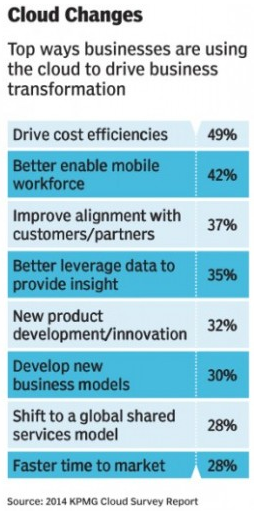 We have seen cloud services become a greater and greater part of our consulting practice over the years, so we know that they appeal to our clients, but we are always curious about why businesses are switching to the cloud. We recently came across a cloud survey by KPMG, in which they polled a wide range of companies about their use of cloud services. It was a little thick with corporate speak catchphrases, but nevertheless, I wanted to share some of their insights here.
We have seen cloud services become a greater and greater part of our consulting practice over the years, so we know that they appeal to our clients, but we are always curious about why businesses are switching to the cloud. We recently came across a cloud survey by KPMG, in which they polled a wide range of companies about their use of cloud services. It was a little thick with corporate speak catchphrases, but nevertheless, I wanted to share some of their insights here.
One thing that stood out was that, while saving money still ranks as the most common reason businesses are moving to the cloud, more and more businesses are using the cloud to drive process improvements.
Here are the top reasons that businesses are switching to the cloud.
Save Money
It should come as no surprise that most businesses are moving to the cloud to save money. We have seen many of our own customers benefit from the cost efficiencies of various cloud services, such as Office 365. But it should be noted that not every project can provide cost savings. Consider this from a recent CIO.com article about a government cloud project:
While considerable focus has been on the potential savings achievable from cloud computing, the real benefits are arguably in other areas. These include time to deploy new solutions, scalability to avoid costs by preventing the overprovisioning of capacity, and elasticity to meet fluctuating workloads.
This definitely rings true for small startups. Many new business may be choosing between building an Exchange server or just using a cloud email service. It’s much simpler and cheaper to start out with a cloud service such a Office 365 or Google Apps, in which you can create a few accounts for your initial employees and then scale up as you add more employees. Trying to do the same thing in-house will require a much bigger initial capital outlay and multiple upgrades as your demand grows. If one of your goals is to save money on IT, the key is to carefully evaluate the available options and pick the projects most likely to accomplish that.
Enable Your Mobile Workforce

Cell phone addiction seems to be rampant, so businesses might as well take advantage of it. At least work email is more productive than Facebook (if you ignore your family at dinner while staring your phone). Actually, many of us could benefit from a digital detox, mobile addiction is a serious issue, and I don’t want to make light of it. But mobile computing has been the largest paradigm shift in computing in the past decade and has been a big player in the consumerization of IT. Even the aging encumbent Microsoft is pivoting to try to position itself as a cloud and mobile company. The cloud enables much richer and more powerful mobile apps by taking over the computational heavy lifting, which mobile devices are incapable of. There are a huge array of cloud powered apps available to choose from. It’s good to have a trusted advisor by your side to assist in separating the wheat from the chaff.
Align with Customers and Partners
The KPMG report pointed out that retail is getting the most benefit from the cloud by better aligning with customers and partners. Other sectors definitely benefit from this as well. A common example is the adoption of DropBox by businesses to share documents with partners, since many people are familiar with that platform. Unfortunately, DropBox has had numerous problems with security over the years and is having a hard time gaining the trust of corporate IT departments. The consumerization of IT deserves an entirely separate discussion. I get it. Users want to do their jobs in the simplest way they can. They sometimes haven’t had training in the IT systems provided by their employers or they forget how to use the generally more cumbersome solutions provided by security conscious IT groups. So the burden is really on us in IT to help our business clients find the right balance between security and usability when collaborating with partners and communicating with customers.
Find Your Own Flight Path
If your company is considering a cloud project, it’s a good idea to briefly review the current trends in cloud computing. Of course, most small and mid-sized businesses can’t afford to hire a Big Four consulting firm to help with their cloud project. At Aviator, we have been helping small and mid-sized Bay Area companies migrate to the cloud for the past ten years. Contact us today and let’s talk about the lessons we can learn from the industry leaders, and how to leverage these insights to help your business flourish.
